Recognizing Foreshocks -- Answers

Example #1
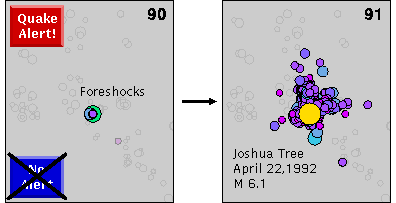
Correct answer: Issue Earthquake Alert!
Good job! You guessed correctly.
The tight cluster of earthquake epicenters seen in frame 90 were foreshocks
to the Joshua Tree earthquake, a magnitude 6.1 right-lateral strike-slip
earthquake which occurred on April 22, 1992, just north of the southern
San Andreas fault zone. This cluster included an earthquake of magnitude
4.6, a notable earthquake in its own right. In the image of day 91 seismicity,
you can see the numerous aftershocks produced by the Joshua Tree earthquake.
Select Another Animation
or
Return to the Activity #10 Introduction

Example #2
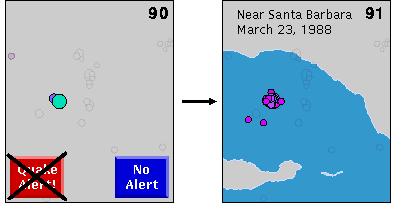
Correct answer: No Alert Issued
Good guess! You delivered a successful forecast.
Only small aftershocks followed the magnitude 4 earthquake that
occurred in frame 90 of this animation, so there was no need for
an earthquake alert to be issued. The setting of this animation,
as you can see in the image of day 91 (March 23, 1988) seismicity,
is primarily offshore, south of Santa Barbara -- that's Santa Cruz
Island at lower left.
Select Another Animation
or
Return to the Activity #10 Introduction

Example #3
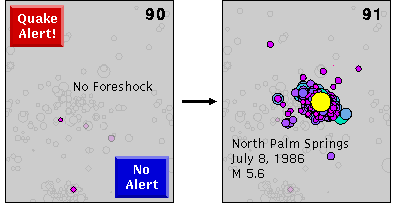
Correct answer: either (see below)
You decided to issue an earthquake alert on the 90th day, and sure enough,
there was a large earthquake on day 91 -- the North Palm Springs mainshock,
a magnitude 5.6 right-lateral strike-slip earthquake that struck (as the
name implies) north of Palm Springs on July 8, 1986. In that sense, your
forecast was correct.
However, if you look carefully at the frame for day 90, and then at day 91
(ignore the aftershock "cloud" and concentrate on the mainshock),
you'll note that none of the seismicity on day 90 occurred in the same
location as the North Palm Springs mainshock. Hence, there were no
foreshocks to this earthquake, so you can't claim that your forecast
was based on foreshock activity. Therefore, had you not issued an alert,
you would have also been correct (in a different sense), since your
forecast was supposed to be based on identification of foreshocks.
Of course, the fact that a large earthquake occurred in this case
means that residents of the area would probably have preferred the
former sense of "correct" to the latter!
Select Another Animation
or
Return to the Activity #10 Introduction

Example #4
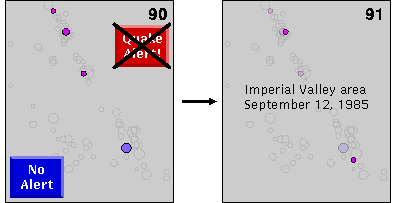
Correct answer: No Alert Issued
Nice call! You made the correct decision with this forecast.
This animation covered 90 days leading up to September 12, 1985,
a very uneventful day in the Imperial Valley of extreme
southern California. You may have noticed a linear trend in the
seismicity cutting diagonally across the area -- this is the Imperial
fault zone, one of the most active in all of California. However,
in this animation, and the day that followed it, that activity was
nothing to worry about, and so the correct response to this
90-day sequence was to issue no alert.
Select Another Animation
or
Return to the Activity #10 Introduction

Example #5
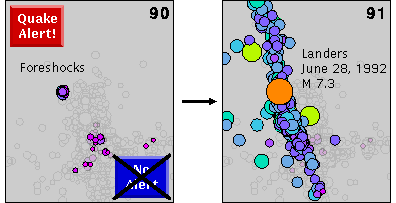
Correct answer: Issue Earthquake Alert!
Good work! Your forecast was correct.
The earthquake that followed these 90 days was the largest in
southern California since 1952 -- the magnitude 7.3 right-lateral
strike-slip Landers earthquake of June 28, 1992. You can see
the linear fault trace of the Landers rupture clearly outlined
by aftershocks in the image of day 91 seismicity. The site of
the Landers mainshock epicenter is the same as the small cluster
of microseismicity (quakes smaller than magnitude 3) seen just
left of center in frame 90, meaning that those earthquakes were
foreshocks of the Landers mainshock. Theoretically, they could
have warned of the impending major earthquake. Therefore, you
were justified in issuing an earthquake alert!
The large earthquake that occurred on day 24 and
generated the aftershock sequence that lasted throughout the rest of
the animation was the magnitude 6.1 Joshua Tree earthquake.
That earthquake was also preceded by foreshocks, though because of
the partitioning of "days" in this animation, they aren't apparent.
Given how the Joshua Tree aftershock sequence seems to have led directly
into the start of the Landers activity, the Joshua Tree mainshock could
be considered an advance foreshock of sorts to the Landers earthquake.
Select Another Animation
or
Return to the Activity #10 Introduction

Example #6
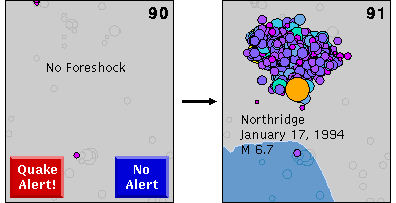
Correct answer: either (see below)
Your decision to issue an alert after watching these 90 days
of activity was technically correct -- a large earthquake struck
the area on day 91. This was the devastating Northridge mainshock
of January 17, 1994, a magnitude 6.7 earthquake which ruptured
a blind thrust fault northwest of Los Angeles (you
can see Santa Monica Bay at lower left on the day 91 image).
But if you look on the day 90 frame, you'll note that the
site of the eventual Northridge epicenter is devoid of seismic
activity immediately prior to the rupture. This means there was
no foreshock to this mainshock; you would have been justified
(though not very highly rewarded) had you not issued an
alert on day 90. Essentially, if you issued an alert based
on seismicity patterns in this case, you'll have a hard time
arguing that it was based in anything more than pure luck.
Before you move on, did you notice the pattern of aftershocks
associated with the Northridge mainshock in the day 91 frame?
Given that this earthquake occurred on a thrust fault striking
roughly east-west, and that the hypocenter was located near
the base of that fault, which way does that fault dip?
Select Another Animation
or
Return to the Activity #10 Introduction


Return to the first page
of Activity #10

![]()

![]()

![]()

![]()

![]()

![]()